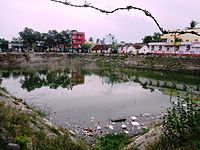Yathothkari Perumal Temple
| Tiruvekka Temple | |
|---|---|
Yathokthakari Temple | |
 | |
| Religion | |
| Affiliation | Hinduism |
| District | Kanchipuram |
| Deity | Yathothkari (Vishnu) |
| Location | |
| Location | Kanchipuram |
| State | Tamil Nadu |
| Country | India |
Location in Tamil Nadu | |
| Geographic coordinates | 12°49′27″N 79°42′44″E / 12.82417°N 79.71222°E |
| Architecture | |
| Type | Dravidian architecture |
Tiruvekkaa Temple or Yathothkari Perumal Temple (locally called Sonnavannam Seitha Perumall) is a
The temple is considered one of three oldest Vishnu temples in Kanchipuram, the other two being
Yathothkari Perumal is believed to have appeared for
Legend

As per Hindu legend, once there was an argument between
Once sage Bhargava had a son through Kanakangi, a celestial dancer. The boy was stillborn and was not fully developed during his birth. Kanakangi left his son under bushes and left to celestial world. It is believed that the child was a divine incarnation of one of Vishnu's weapons, the
Thirumalisai had a disciple by name Kanikkannan. He also had an old lady serving him - Thirumalisai prayed to the presiding deity of the temple and by the grace of Bhujangasayana Perumal, the old lady became a beautiful young lady. The Pallava king who was ruling the region at that time got attracted by the lady and married her. With time while the king was growing older, the lady remained young. He called up Kanikannan and ordered to sing praise of him so that he also turned young. When he refused, the king ordered Kanikannan to be banished out of the country. Kanikannan explained this to his master Thirumalisai, who prayed to Bhujangasayana Perumal. When the king heard this, he ordered the three to be sent of the country, which they obliged. When the three left Kanchipuram, it was engulfed in darkness. Realising his sin, the king worshipped Bhujangasayana Perumal to return along with his two devotees. Since the presiding deity obliged to his devotees wishes, he is called Yathothkari Perumal. Yathothka means as requested and kari denotes the person who accomplishes the task.[2][3] One of the Alvars, poet saints of 7-10th century, Poigai Alvar was born at this temple.[6]
History
The temple is considered one of three oldest Vishnu temples in Kanchipuram, the other two being
Architecture

The temple in Chinna Kanchipuram, a locality in the Eastern side of
Festivals and religious practices
The temple follows the traditions of the
Religious importance
The temple finds mention in Perumpaanatrupadai written by
The temple is considered the birthplace of
Notes
- ^ https://archive.org/details/pattupattutentamilidyllschelliahj.v._108_Q/page/127/mode/2up
- ^ a b c d e MS 1993, pp. 66-72
- ^ a b c R. 2001, pp. 557-8
- ^ Rao 2012, p. 52
- ^ a b Aiyar, Indira S (1 September 2013). "Visnu Temples of Kancipuram". Marg, A Magazine of the Arts. Archived from the original on 27 April 2018. Retrieved 26 April 2018.
- ^ Ayyar 1991, p. 539
- ^ Madhavan 2007, pp. 4-5
- ^ a b c d Madhavan 2007, pp. 17-20
- ^ https://archive.org/details/pattupattutentamilidyllschelliahj.v._108_Q/page/127/mode/2up
- ISBN 978-81-87952-12-1.
- ^ a b "Sri Son vannam seitha perumal temple". Dinamalar. 2014. Retrieved 31 May 2014.
- ^ a b Chari, T. V. R. (1982). The Glorious Temples of Kanchi. Big Kancheepuram: Sri Kanchi Kamakshi Ambal Devasthanam and Sarada Navaratri Kalai Nigazhchi Trust. pp. 17–24.
- ISBN 978-93-83440-34-4.
- ^ "Alwar utsavam". The Hindu. 20 October 2003. Archived from the original on 3 January 2004. Retrieved 22 April 2014.
- ^ Dalal 2011, p. 308
- ISBN 9788120810983.
- ^ Bühler, Georg; Kielhorn, Franz; Lüders, Heinrich; Wackernagel, Jacob (1897). Grundriss der indo-arischen Philologie und Altertumskunde: (Encyclopedia of Indo-Aryan research). K.J. Trübner. p. 4.
References
- Ayyar, P. V. Jagadisa (1991). South Indian shrines: illustrated. New Delhi: Asian Educational Services. ISBN 81-206-0151-3.
- M.S., Ramesh (1993). 108 Vaishnavite Divya Desam Volume 1. Tirupati: Tirumala Tirupati Devasthanams.
- Madhavan, Chithra (2007). Vishnu Temples of South India Volume 1 (Tamil Nadu). Chithra Madhavan. ISBN 978-81-908445-0-5.
- R., Dr. Vijayalakshmy (2001). An introduction to religion and Philosophy - Tévarám and Tivviyappirapantam (1st ed.). Chennai: International Institute of Tamil Studies.
- Rao, A.V.Shankaranarayana (2012). Temples of Tamil Nadu. Vasan Publications. p. 52. ISBN 978-81-8468-112-3.
| Part of a series on |
| Vaishnavism |
|---|
 |


